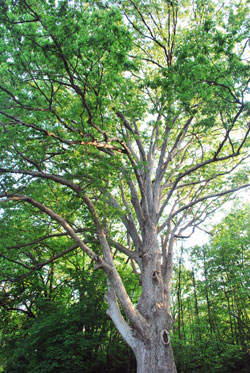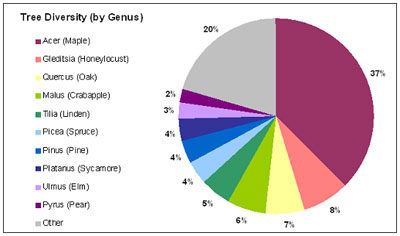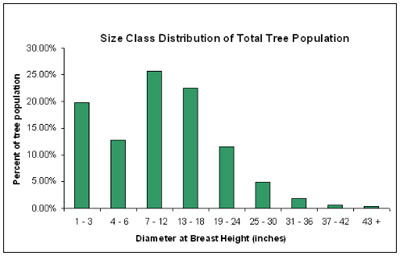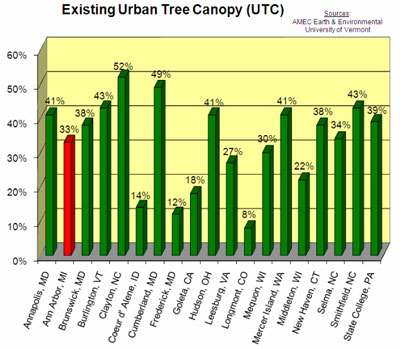Environmental Indicators: Trees
Editor’s Note: This is the fourth in a series of Chronicle pieces on the environmental indicators used by the city of Ann Arbor in its State of Our Environment Report. The report is developed by the city’s Environmental Commission and designed as a citizen’s reference tool on environmental issues and as an atlas of the management strategies underway that are intended to conserve and protect our environment. The report is organized around 10 Environmental Goals developed by the Environmental Commission and adopted by city council in 2007.

This is one of Ann Arbor's more significant trees. Some readers will undoubtedly recognize it and will know its location, type, and age – which they're invited to leave in the comment section.
This month’s report is also an invitation to all readers to participate in the development of Ann Arbor’s first comprehensive Urban Forest Management Plan. A public workshop to help kick off the planning effort is being held on June 1, 2010 from 7-9 p.m. at Forsythe Middle School, 1655 Newport Road.
This spring has been exceptional with both beautiful weather and ample rain. The trees seemed to have noticed, with their early bud break in April and full canopies by mid-May. While we worried for those tender emerging leaves when the temperature dipped below freezing, the trees handled the dips in temperatures just fine and are now flourishing.
That’s good news because the city receives exceptional benefits from our trees. A recent analysis of the publicly managed trees (i.e., trees along streets and mowed areas of parks) estimated that they provide $4.6 million in benefits each year. When you factor in the cost for management, the city receives $2.68 in benefits for every $1 it spends on the municipal forestry program. We think that’s a pretty good rate of return.
What are these benefits and how were they calculated?
How Tree Benefits Are Calculated
In 2009, the city contracted with the Davey Resource Group to conduct a comprehensive inventory of street trees and park trees in mowed areas. Some Ann Arbor residents probably remember seeing the survey work in progress.
Using the data from this newly completed tree inventory, the Davey Resource Group then calculated the values and benefits of the city’s public trees. The city’s website summarizes them on a page titled “Benefits of Urban Forests.” The calculations were done using i-Tree, a suite of peer-reviewed software programs developed by the USDA Forest Service.
The Benefits of City Trees
The city’s public trees conserve and reduce energy, reduce carbon dioxide levels, improve air quality, mitigate stormwater runoff, and provide other benefits associated with aesthetics, increased property values, and quality of life. It’s great to be able to describe these benefits in words but even more powerful when we can show you in numbers. Here are some of the numbers:
- Public trees reduce energy and natural gas use in Ann Arbor from shading and climate effects equal to 3,408 MWh and 1,260,313 therms, for a total savings valued at approximately $2,252,055, with a citywide average of $47.55 per public tree.
- Ann Arbor’s public trees reduce atmospheric CO2 by a net of 7,851 tons per year, valued at $52,450 for an average net benefit per tree of $1.11.
- The net air quality improvement from the removal and avoidance of air pollutants is valued at $395,569 per year, with an average net benefit per tree of $8.35.
- Ann Arbor’s public trees intercept 65.0 million gallons of stormwater annually. The total value of this benefit to the city is $519,895 per year, for an average value of $10.98 per inventoried tree.
- The estimated total annual benefit associated with increased property values, aesthetics, and other less tangible improvements is $1,368,302 per year, for an average of $28.89 per inventoried tree.
You may already be familiar with many of these benefits – at least in general terms – but having a quantifiable figure attached to each of them begins to demonstrate the value of our city’s “green infrastructure.” These trees are an asset that is owned and managed by the city. The city is beginning to develop an urban forest plan to ensure that this resource is sustainable and continues to provide benefits into the future.
Trees are a defining characteristic of Ann Arbor (Tree Town) that make the city a desirable place to visit, work, do business, and live. This month’s indicator report focuses on Ann Arbor’s urban forest, and the metrics used to measure its quality.
Urban Forest Environmental Indicators
The State of Our Environment report includes three indicators for Ann Arbor’s urban forest: Tree Diversity, Size Class, and Urban Tree Canopy.
Indicator: Tree Diversity
Let’s start with tree diversity. The indicator is rated as poor (red) because of the dominance of Maple (Acer) species, and the indicator is improving (upward arrow) because of focused efforts to increase species diversity through new plantings.
The recently completed comprehensive street and park tree inventory cataloged over 40,000 street trees, 6,600 park trees in mowed areas and 8,800 potential planting sites. According to the inventory, Maple (Acer) species makes up nearly 40% of Ann Arbor’s urban forest.
The tree inventory did not account for trees on private property or in city-owned natural areas.
Diversity plays an important role in the long-term stability of an ecosystem. When an area has a high diversity of tree species, it is less likely to suffer catastrophic loss from diseases or pests. For example, consider the impact the Emerald Ash Borer (EAB) had on Ann Arbor ash trees. The Emerald Ash Borer (Agrilus planipennis), an exotic wood-boring beetle discovered in the area in the summer of 2003, has killed more than 10 million trees in southeast Michigan.
Prior to the EAB infestation in 2002, ash trees comprised 17% of Ann Arbor’s tree population. The EAB infestation resulted in the emergency removal of 10,000 ash trees that were planted along public sidewalks and in parks. Planting a diversity of hearty tree species throughout Ann Arbor neighborhoods can reduce the vulnerability of the urban forest to species-specific pests. A good rule of thumb is that no more than 10% of a city’s tree population should consist of one species.
The city of Ann Arbor is increasing urban forest tree diversity through replanting efforts. More than 4,000 trees have been planted since 2004. In fall 2010, an additional 705 trees representing 28 different genera were planted, with more plantings planned in the spring. An important component of the replanting strategy is a focus on diversifying the tree population by planting non-maple species.
Indicator: Size Class
Moving on to the urban forest size class indicator, the news is much better. We rated the indicator as good (green) and improving (upward arrow). It’s hard to tell a tree’s age without cutting it down to count its rings or taking core samples, which damages the tree.
Instead, we use the diameter at breast height (DBH) as a predictor of tree age. Young trees have small DBH measurements and as trees mature, DBH increases. Ann Arbor has a healthy mixture of young, middle, and old individuals and the tree inventory shows a similarly healthy mix of trees.
In the same way that high species diversity reduces a forest’s vulnerability to species-specific pests and diseases, a diverse age structure reduces the possibility that all the trees in the forest will begin to die at the same time. A healthy mixture of young, medium, and old trees provides a nearly constant turnover of generations over time as new trees replace the old. In addition, trees of different sizes provide more complex habitat for wildlife and can support a greater number of species.
An ideal tree population’s age distribution is skewed toward younger trees because it ensures there will be a continuous flow of benefits as mature trees begin to decline.
Indicator: Urban Tree Canopy
The last Urban Forest Indicator is the Urban Tree Canopy (UTC). We rated the indicator as fair (yellow) and stable (flat arrow). This is a new indicator based on very recent and very accurate remote sensing data.
While the tree inventory only looked at publicly managed trees, the canopy cover analysis measures the canopy of the entire city – the cumulative cover of all public- and privately-owned trees. The analysis is based on 2009 “leaf-on” aerial imagery. We rated this indicator as fair (yellow) because, with 33% canopy, the city of Ann Arbor has average or above-average tree canopy cover compared with other small and medium-sized communities in the United States (see Existing UTC Chart below).
With this percent canopy cover, Ann Arbor should focus on maintaining and preserving tree canopy to sustain functional benefits while also targeting areas for improvement. We rated the indicator as stable (flat arrow) because the canopy cover of newly planted trees does not (yet) replace the canopy cover we lose when a large mature shade tree dies.
The UTC analysis provides a rich dataset that can be used with other city GIS layers. For example, this chart shows the canopy cover by creekshed and the potential urban tree canopy within each watershed.
Total Total
Exist. Exist. Poss. Poss.
Total UTC UTC UTC UTC
Creekshed Acres Acres % Acres %
Huron River 4,213 1,646 39.1 1,454 34.5
Fleming Creek 642 184 28.7 311 48.4
Traver Creek 1,578 508 32.2 774 49.0
Honey Creek 815 335 41.1 296 36.4
Millers Creek 1,415 460 32.5 669 47.3
Allen Creek 3,340 1,151 34.5 1,287 38.5
Mallets Creek 5,087 1,427 28.0 2,451 48.2
Swift Run 1,174 303 25.8 667 56.8
-
Using these new data, GIS tools, and input from the public engagement process, we will develop an Urban Forest Management Plan that maximizes the benefits of the urban forest while meeting the needs and values of the community.
Paths to Contribution
Are you interested in trees? Do you want to influence how trees in the city of Ann Arbor are managed?
Participate in the Process: Urban Forest Management Plan
Join us on Tuesday, June 1 from 7-9 p.m. at Forsythe Middle School, 1655 Newport Road, to learn about Ann Arbor’s urban forest and to share your ideas about the tree planting, tree trimming, tree removals and the development of the city’s first urban forest management plan. Go to the urban forestry website for more information.
Educate Yourself
Learn about the trees in your neighborhood. The city’s data catalog includes a Google Earth file of every tree in our inventory. [.kmz file of Ann Arbor Google Earth Tree Data – note that this is a very large file]
Get Your Hands Dirty
Help plant the city’s trees. More information on that is available on the city’s website: www.a2gov.org/trees
Volunteer at events sponsored by the city’s Natural Area Preservation Program and Adopt-a-Park program that are helping to improve the urban forest.
Maintain Your Private Trees
- Ensure that newly planted trees are watered weekly, if we receive no rain.
- Avoid the untimely death of young trees from weed whip and lawn mower damage by mulching around your trees (be sure to keep mulch away from the trunk).
- Prune young trees to improve their structure and prune out dead, diseased or dying limbs in mature trees. Hire a certified arborist if the tree is too large to safely prune it yourself.
About the authors: Kerry Gray is the urban forestry and natural resources planning coordinator; Matthew Naud is the city’s environmental coordinator; and Adrienne Marino is environmental programs assistant. They’re all staff with the city of Ann Arbor.










Wurster Park-oak
Quercus muehlenbergii
The tree that Hieftje hugged on his bike ride.
Informative article, and hopefully many readers will attend the June 1st meeting!
A clarification, the trees are owned [insert "by the citizens of Ann Arbor"] and managed by the city.
The benefits mentioned are provided by MATURE trees, which calls into question why the city (and DDA) continues to cut down mature trees rather than trying to save them with pruning, cabling, and other restorative techniques.
Planting is good, but it will be 20-30 years before trees planted today provide canopy and other benefits. Let us make preserving what we have A POLICY PRIORITY!
Our urban forest, and our street trees in particular, are in a poor state of health overall. Their condition has deteriorated considerably over the past 5 to 10 years, and continue to do so. Like budgets for our roads, bridges, and parks, city funds for forestry work and staffing has been cut to bare minimums. We are caring for our urban forest on a “crisis-management basis”. Sadly, unlike a road, bridge or park that can be repaired or rebuilt in a relatively short time period, the decline of our trees and urban forest will take many, many years – - perhaps decades, to reverse.
We used to have a stellar forestry department and city forester, most of whom were intimately knowledgeable about the trees in Ann Arbor, were passionate about their work, and had many years of experience in their field.
They had short and long-range plans and were organized in their work. They were not “tree-huggers” in the pejorative sense, and certainly had to remove many trees in their tenure – - but they also knew the value of saving a tree when reasonably possible, and the importance of regular maintenance and tree replacement. Most of this is now absent in our forestry department. One of the last remaining forestry staff employee that fits this description was fired recently by the city.He had been with the city for many years and was one of the most experienced and knowledgeable field crew they had.
At this time of year, it’s pretty easy to drive around town and admire our plentiful and beautiful trees – - and make the assumption that all is well. Here is some information about our 40,000+ street trees:
(1) Only seven percent of our trees are in the “large” category, according to our $200K Davey Tree Report. A healthy urban forest should have 20%, according to Davey. Trees of this size give the maximum return in terms of energy reduction, stormwater absorption, air quality, and property values. And while the it was said that “Ann Arbor should focus on maintaining and preserving tree canopy to sustain functional benefits while also targeting areas for improvement ” current forestry practices do not seem to reflect a desire to keep and maintain our largest trees. Hundreds and hundreds of them have been removed or damaged – - mostly maples – - due to neglect, or at the direction of the forestry department. Obviously, some removals were necessary. And yes, we have an overabundance of maples in our inventory, but does that justify removing large and contributing trees of any species? Some examples:
(a) Many or most have been removed due to sidewalk issues. We used to value trees over sidewalks, and employed reasonable methods to retain the tree AND replace the sidewalk. No more.Over and over again I have witnessed the city spend thousands of dollars to remove a large tree, rather than spend a much lesser amount to remedy the sidewalk situation.
(b) Homeowner requests. I am aware of many, many instances where a homeowner has expressed concern about a large tree, and asked to have it evaluated, trimmed, or removed. In many, many instances, rather than offering information and alternatives to removal, the city has either agreed with a concerned but uninformed homeowner, or convinced the homeowner that removal is the only option.
(c) The Downtown Development Authority is apparently exempt from getting permission to remove trees. They have removed many, many healthy and savable large trees with no communication to or permission from the forestry department. Yes, they’ve planted 2 or 3 inch diameter trees in the place of the ones they cut down, but it will be 20 years or more before these new trees provide the benefits of the one they removed.
(d) Contractor damage. The city is required to ensure that crews working on sidewalks, sewer/water lines, and construction projects observe certain practices to minimize damage to trees in the area. This is seldom enforced, and I have witnessed sidewalk replacement crews, in the interests of expediency, cutting off the major roots of large trees, as well as construction sites with little or no protection to existing trees. These trees will soon die and have to removed in the near future.
(2) We have 800+ stumps that need removal. Some of these stumps have been left for 5 years or more.
(3) 27,000 ( yes, twenty-seven thousand) of our trees need routine pruning. It has been 7 years or more since crews have performed routine maintenance work on our trees. 4,000 more of them need priority pruning. How many trees can be pruned in the time it takes to remove a large tree? 3? 5? 10? How many of these trees will soon need to be removed due to lack of care?
(4) We have 8000 to 9000 city planting sites waiting for a tree – - mostly sites where a tree was removed in past years and not replaced. New trees are being replanted at the rate of about 600 to 700 per year – - much of it done by service clubs and neighborhood volunteer groups. Sadly, many of these trees get little or no care after planting (water and pruning), and thus the survival rate is not very good. Most of the young trees in our inventory are badly in need of a “training prune”, which significantly affects their health in later years.
So, we’ve got most of our street trees in need of immediate care, not nearly enough new trees being planted, and no change for the foreseeable future.
The city now wants our input for their “Urban Forest Management Plan”. More than a “plan” or a “policy” or “guidelines”, we need a tree ORDINANCE – - with funding and a governing board to ensure compliancy – just like the building department or planning department or transportation department and their boards and commissions. This is the instrument by which a city can best ensure that their trees will be cared for in a consistent and perpetual manner – - irrespective of the city manager, city council, or mayor in place at any given time.
I am cautiously optimistic that these meetings will do more than to simply serve the requirement that public input be allowed. I am also hopeful that the committee,commission, or board formed to develop the Urban Forest Management Plan is not simply many hand-picked “yes” people, already well-entrenched with city government, and appointed for their predictable positions.. It should, and must, be comprised of local residents, owners of local nurseries and tree companies, University of Michigan forestry staff, local tree and environmental advocacy groups, and the like. I imagine there should also be a forestry staff and/or city council appointment as well. The make-up of this group will give us all an early glimpse of what we can expect to happen.
Finally, even though our “Tree Town” designation requires, among other items, that we have a tree care ordinance with specific features, we do not – - and apparently never have had a tree ordinance – so I’m not sure how we originally qualified for, or keep qualifying for, the Tree Town designation. I have a series of emails on this subject, directed to the Arbor Day Foundation and the Michigan Department of Natural Resources. I either received no answers or very evasive ones over a period of six months .No one, to date, including the Ann Arbor Forestry Department, can show that such an ordinance exists. [link]
I am no expert in this area – - just a local tax-payer and resident that has been active in the past year with local tree issues. My primary intent is not to place blame or invoke hostilities. Indeed, I think many of the current forestry staffers are doing the best they can with the resources allowed them by our budget and administrators. But, the facts are the facts – - and we must do better, and quickly.
I understood 1,000 to 1,200 trees are being planted each year. Most by the city. The city lost 10,000 in the ash borer crisis and may have been the hardest hit city in the whole Midwest.
I think the city is doing a decent job working on trees. We should cut them some slack on what they can’t get done.
It is kind of amazing with what has happened to the economy, state revenue sharing and Pfizer taking away so much of the property tax income that the city is able to keep so many service balls in the air. Services are being maintained way better here than in other Michigan cities.
They do need to keep planting and yes maintain the budget for forestry from here on out if possible but these are the worst economic times 90% of us have experienced in our lifetimes.
Governments in Michigan are facing deep cuts to the bone of
services, closing facilities and laying off scads of staff and here in Ann Arbor we have the time and money to worry about trees.